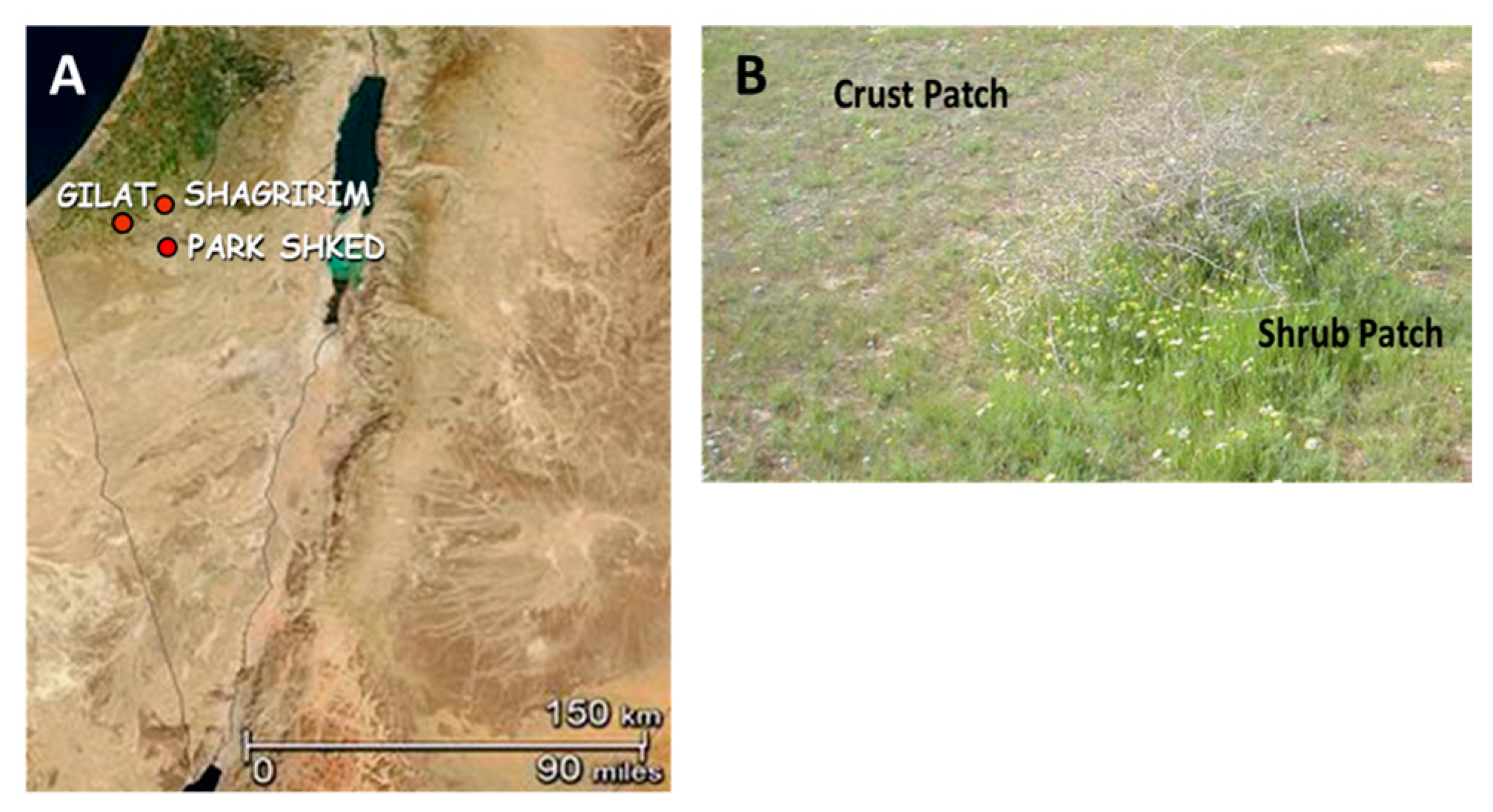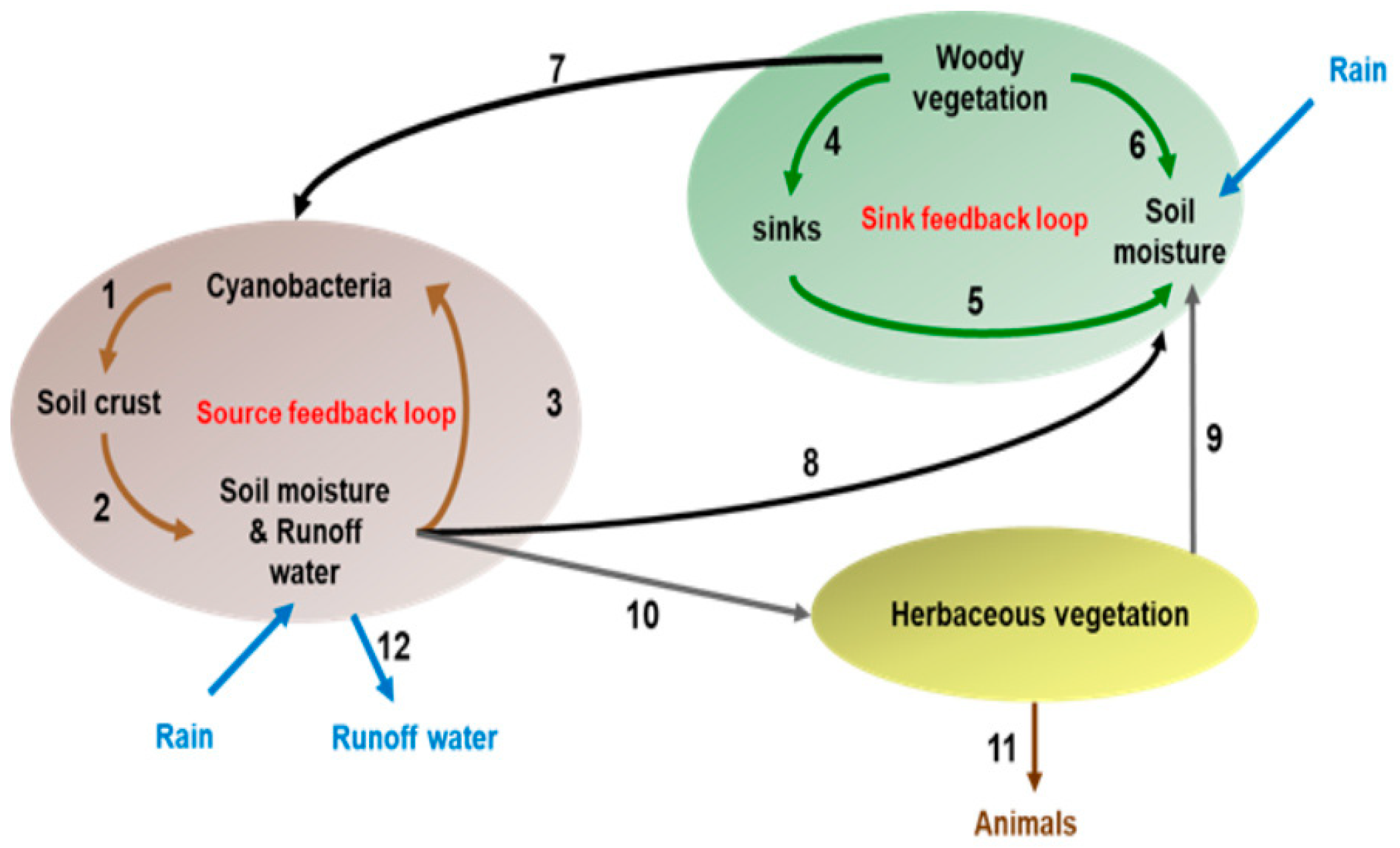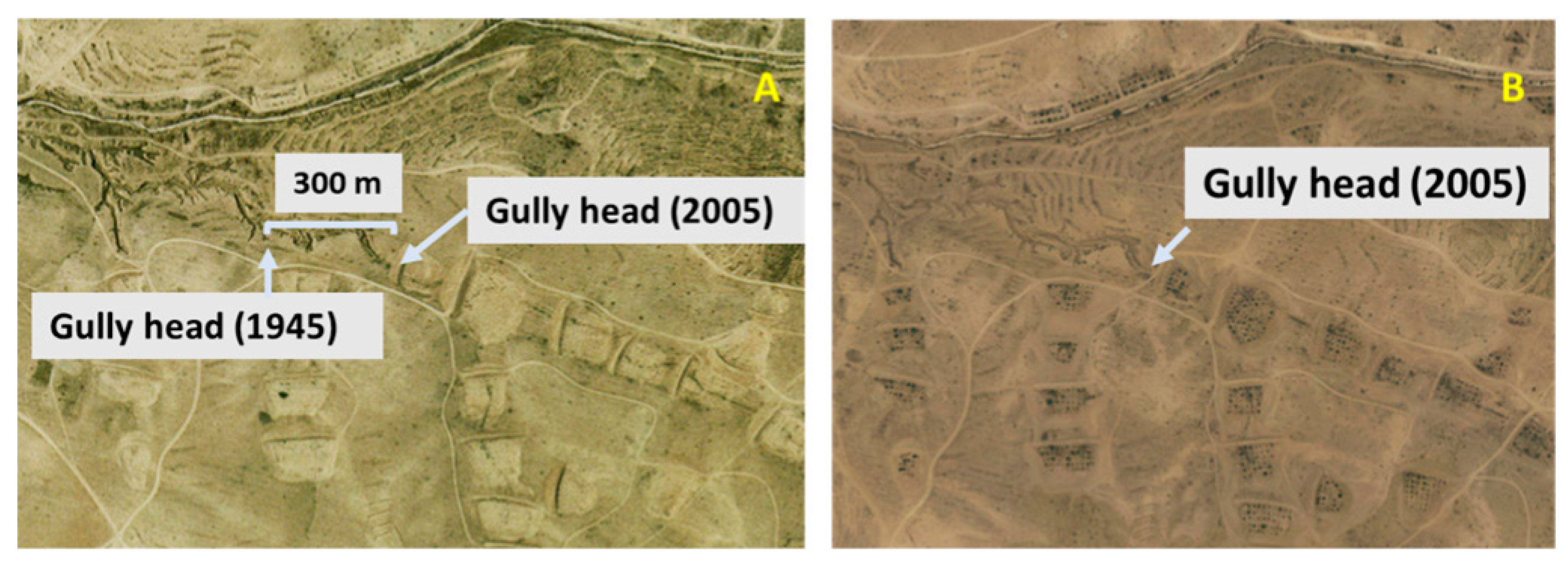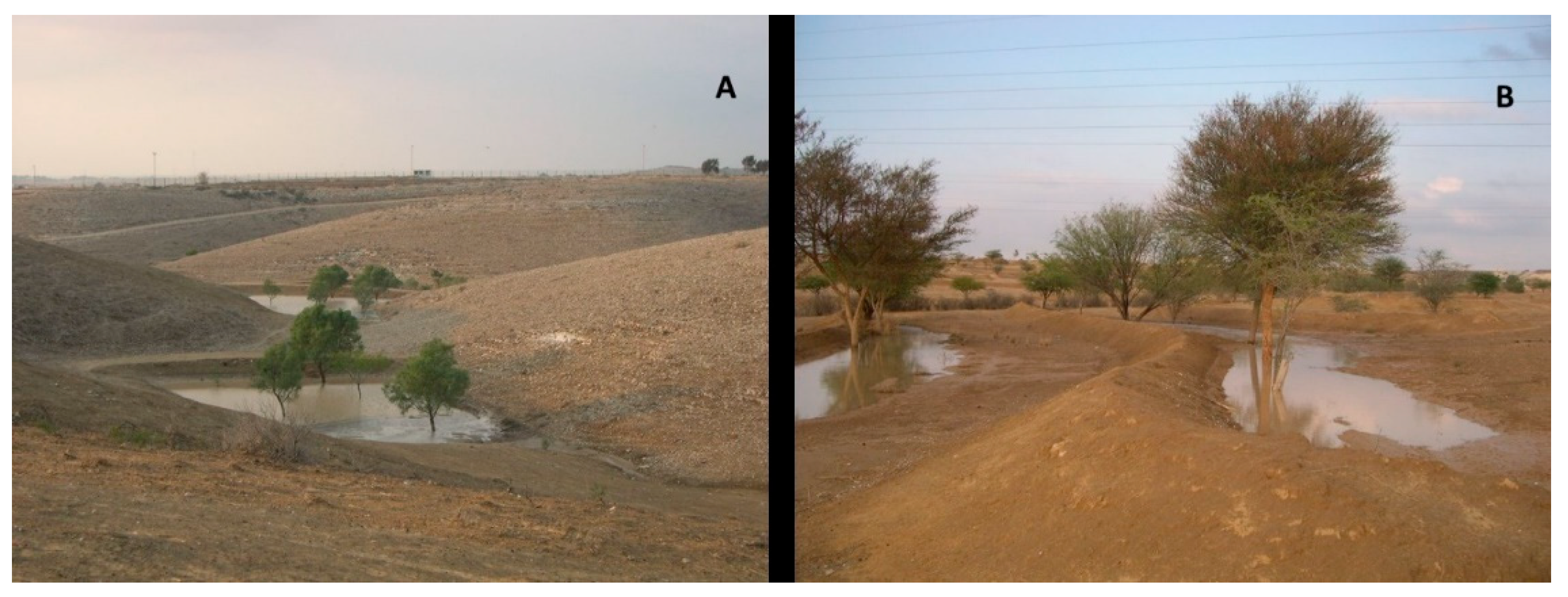Functional Restoration of Desertified, Water-Limited Ecosystems: The Israel Desert Experience
Abstract
1. Introduction
2. Functional Restoration of Degraded Landscapes—Guiding Principles
2.1. Identifying the Fundamental Processes That Regulate Ecosystem Functions
2.2. Detecting Drivers Leading to Degraded States
2.3. Functional Restoration: State Change in Degraded Landscape
2.4. Monitoring the Restoration Impact and Assessing Its Success in Terms of Ecosystem Services
3. Discussion
3.1. Identifying the Fundamental Processes That Regulate Ecosystem Functions in Alternative States
3.2. Detecting Drivers Leading to Degraded States
3.3. Functional Restoration Actions Aimed at Changing the State of the Degraded Landscape
3.4. Monitoring the Restoration Impact and Assessing Its Success in Terms of Ecosystem Services
4. Conclusions
Author Contributions
Funding
Data Availability Statement
Acknowledgments
Conflicts of Interest
References
- Ruiz-Jaen, M.C.; Aide, T.M. Restoration Success: How Is It Being Measured? Restor. Ecol. 2005, 13, 569–577. [Google Scholar] [CrossRef]
- Majer, J.D. Animals in the Restoration Process-Progressing the Trends. Restor. Ecol. 2009, 17, 315–319. [Google Scholar] [CrossRef]
- Van Andel, J.; Aronson, J. Restoration Ecology: The New Frontier, 2nd ed.; John Wiley & Sons: Hoboken, NJ, USA, 2012. [Google Scholar]
- Science & Policy Working Group. The SER international primer on ecological restoration. Soc. Ecol. Restor. 2004, 2. Available online: https://cdn.ymaws.com/www.ser.org/resource/resmgr/custompages/publications/ser_publications/ser_primer.pdf (accessed on 1 January 2023).
- Ehrenfeld, J.G.; Toth, L.A. Restoration Ecolog y and the Ecosystem Perspective. Restor. Ecol. 1997, 5, 307–317. [Google Scholar] [CrossRef]
- Young, T.P.; Petersen, D.A.; Clary, J.J. sThe ecology of restoration: Historical links, emerging issues and unexplored realms. Ecol. Lett. 2005, 8, 662–673. [Google Scholar] [CrossRef]
- Wright, J.; Symstad, A.; Bullock, J.M.; Engelhardt, K.; Jackson, L.; Bernhardt, E. Restoring biodiversity and ecosystem function: Will an integrated approach improve results? In Biodiversity, Ecosystem Functioning, and Human Wellbeing: An Ecological and Economic Perspective; Oxford University Press: Oxford, UK, 2009. [Google Scholar]
- Aerts, R.; Honnay, O. Forest restoration, biodiversity and ecosystem functioning. BMC Ecol. 2011, 11, 29. [Google Scholar] [CrossRef]
- Choi, Y.D.; Temperton, V.M.; Allen, E.B.; Grootjans, A.P.; Halassy, M.; Hobbs, R.J.; Naeth, M.A.; Török, K. Ecological resto-ration for future sustainability in a changing environment. Ecoscience 2008, 15, 53–64. [Google Scholar] [CrossRef]
- Kollmann, J.; Meyer, S.T.; Bateman, R.; Conradi, T.; Gossner, M.M.; Mendonca, M., Jr.; Fernandes, G.W.; Hermann, J.-M.; Koch, C.; Müller, S.C.; et al. Integrating ecosystem functions into restoration ecology-recent advances and future directions. Restor. Ecol. 2016, 24, 722–730. [Google Scholar] [CrossRef]
- Leu, S.; Mussery, A.M.; Budovsky, A. The Effects of Long Time Conservation of Heavily Grazed Shrubland: A Case Study in the Northern Negev, Israel. Environ. Manag. 2014, 54, 309–319. [Google Scholar] [CrossRef]
- Ore, G.; Bruins, H.J. Design features of ancient agricultural terrace walls in the negev desert: Human-made geodiversity. Land Degrad. Dev. 2012, 23, 409–418. [Google Scholar] [CrossRef]
- Shahack-Gross, R.; Boaretto, E.; Cabanes, D.; Katz, O.; Finkelstein, I. Subsistence economy in the Negev Highlands: The Iron Age and the Byzantine/Early Islamic period. Levant 2014, 46, 98–117. [Google Scholar] [CrossRef]
- Avni, Y.; Porat, N.; Avni, G. Pre-farming environment and OSL chronology in the Negev Highlands, Israel. J. Arid. Environ. 2012, 86, 12–27. [Google Scholar] [CrossRef]
- Li, X.; Song, W.; Gao, Y.; Zheng, J.; Jia, R. Effects of crust and shrub patches on runoff, sedimentation, and related nutrient (C, N) redistribution in the desertified steppe zone of the Tengger Desert, Northern China. Geomorphology 2008, 96, 221–232. [Google Scholar] [CrossRef]
- Okin, G.S.; Parsons, A.J.; Wainwright, J.; Herrick, J.E.; Bestelmeyer, B.T.; Peters, D.C.; Fredrickson, E.L. Do Changes in Connectivity Explain Desertification? Bioscience 2009, 59, 237–244. [Google Scholar] [CrossRef]
- Rango, A.; Tartowski, S.; Laliberte, A.; Wainwright, J.; Parsons, A. Islands of hydrologically enhanced biotic productivity in natural and managed arid ecosystems. J. Arid. Environ. 2006, 65, 235–252. [Google Scholar] [CrossRef]
- Shachak, M.; Sachs, M.; Moshe, I. Ecosystem Management of Desertified Shrublands in Israel. Ecosystems 1998, 1, 475–483. [Google Scholar] [CrossRef]
- Avni, Y. Gully incision as a key factor in desertification in an arid environment, the Negev highlands, Israel. Catena 2005, 63, 185–220. [Google Scholar] [CrossRef]
- Avni, Y.; Porat, N.; Plakht, J.; Avni, G. Geomorphic changes leading to natural desertification versus anthropogenic land conservation in an arid environment, the Negev Highlands, Israel. Geomorphology 2006, 82, 177–200. [Google Scholar] [CrossRef]
- Peters, D.P.C.; Okin, G.S.; Herrick, J.E.; Savoy, H.M.; Anderson, J.P.; Scroggs, S.L.P.; Zhang, J.; Peters, D.P.C.; Okin, G.S.; Herrick, J.E.; et al. Modifying connectivity to promote state change reversal: The importance of geomorphic context and plant–soil feedbacks. Ecology 2020, 101, e03069. [Google Scholar] [CrossRef]
- Merino-Martín, L.; Breshears, D.D.; Heras, M.M.D.L.; Villegas, J.C.; Pérez-Domingo, S.; Espigares, T.; Nicolau, J.M. Ecohydrological Source-Sink Interrelationships between Vegetation Patches and Soil Hydrological Properties along a Disturbance Gradient Reveal a Restoration Threshold. Restor. Ecol. 2012, 20, 360–368. [Google Scholar] [CrossRef]
- Collins, S.; Belnap, J.; Grimm, N.; Rudgers, J.; Dahm, C.; D’Odorico, P.; Litvak, M.; Natvig, D.; Peters, D.; Pockman, W.; et al. A Multiscale, Hierarchical Model of Pulse Dynamics in Arid-Land Ecosystems. Annu. Rev. Ecol. Evol. Syst. 2014, 45, 397–419. [Google Scholar] [CrossRef]
- Hoekstra, T.W.; Shachak, M. Arid Lands Management: Toward Ecological Sustainability; University of Illinois Press: Champaign, IL, USA, 1999; Available online: https://books.google.co.jp/books?hl=en&lr=&id=yWgQv1NhdZkC&oi=fnd&pg=PP11&dq=Arid+lands+management:+Toward+ecological+sustainability&ots=3EBMg1gjq9&sig=3eI5qGapCDS-OOzhCOU9F2WcOGs&redir_esc=y#v=onepage&q=Arid%20lands%20management%3A%20Toward%20ecological%20sustainability&f=false (accessed on 1 January 2023).
- Suding, K.N.; Gross, K.L.; Houseman, G.R. Alternative states and positive feedbacks in restoration ecology. Trends Ecol. Evol. 2004, 19, 46–53. [Google Scholar] [CrossRef] [PubMed]
- Boeken, B.; Orenstein, D. The effect of plant litter on ecosystem properties in a Mediterranean semi-arid shrubland. J. Veg. Sci. 2001, 12, 825–832. [Google Scholar] [CrossRef]
- Buis, E.; Veldkamp, A.; Boeken, B.; van Breemen, N. Controls on plant functional surface cover types along a precipitation gradient in the Negev Desert of Israel. J. Arid. Environ. 2009, 73, 82–90. [Google Scholar] [CrossRef]
- Karnieli, A.; Gabai, A.; Ichoku, C.; Zaady, E.; Shachak, M. Temporal dynamics of soil and vegetation spectral responses in a semi-arid environment. Int. J. Remote. Sens. 2002, 23, 4073–4087. [Google Scholar] [CrossRef]
- Wright, J.P.; Jones, C.G.; Boeken, B.; Shachak, M. Predictability of ecosystem engineering effects on species richness across environmental variability and spatial scales. J. Ecol. 2006, 94, 815–824. [Google Scholar] [CrossRef]
- Boeken, B.; Shachak, M. Desert Plant Communities in Human-Made Patches--Implications for Management. Ecol. Appl. 1994, 4, 702–716. [Google Scholar] [CrossRef]
- Eldridge, D.; Zaady, E.; Shachak, M. Infiltration through three contrasting biological soil crusts in patterned landscapes in the Negev, Israel. Catena 2000, 40, 323–336. [Google Scholar] [CrossRef]
- Shachak, M.; Boeken, B.R. Patterns of biotic community organization and reorganization: A conceptual framework and a case study. Ecol. Complex. 2010, 7, 433–445. [Google Scholar] [CrossRef]
- Eldridge, D.J.; Zaady, E.; Shachak, M. Microphytic crusts, shrub patches and water harvesting in the Negev Desert: The Shikim system. Landsc. Ecol. 2002, 17, 587–597. [Google Scholar] [CrossRef]
- Sancho, L.G.; Maestre, F.T.; Büdel, B. Biological soil crusts in a changing world: Introduction to the special issue. Biodivers. Conserv. 2014, 23, 1611–1617. [Google Scholar] [CrossRef]
- Hoffman, O.; Yizhaq, H.; Boeken, B.R. Small-scale effects of annual and woody vegetation on sediment displacement under field conditions. Catena 2013, 109, 157–163. [Google Scholar] [CrossRef]
- Segoli, M.; Ungar, E.D.; Shachak, M. Shrubs enhance resilience of a semi-arid ecosystem by engineering and regrowth. Ecohydrology 2008, 1, 330–339. [Google Scholar] [CrossRef]
- Chen, L.; Fu, B.; Zhao, W. Source-sink landscape theory and its ecological significance. Front. Biol. China 2008, 3, 131–136. [Google Scholar] [CrossRef]
- Peters, D.P.C.; Yao, J.; Sala, O.E.; Anderson, J.P. Directional climate change and potential reversal of desertification in arid and semiarid ecosystems. Glob. Chang. Biol. 2012, 18, 151–163. [Google Scholar] [CrossRef]
- Soliveres, S.; Maestre, F.T. Plant–plant interactions, environmental gradients and plant diversity: A global synthesis of community-level studies. Perspect. Plant Ecol. Evol. Syst. 2014, 16, 154–163. [Google Scholar] [CrossRef] [PubMed]
- Zaady, E.; Levacov, R.; Shachak, M. Application of the Herbicide, Simazine, and its Effect on Soil Surface Parameters and Vegetation in a Patchy Desert Landscape. Arid. Land Res. Manag. 2004, 18, 397–410. [Google Scholar] [CrossRef]
- Shachak, M.; Lovett, G.M. Atmospheric deposition to a desert ecosystem and its implications for management. Ecol. Appl. 1998, 8, 455–463. [Google Scholar] [CrossRef]
- Zaady, E.; Groffman, P.; Shachak, M. Nitrogen fixation in macro- and microphytic patches in the Negev desert. Soil Biol. Biochem. 1998, 30, 449–454. [Google Scholar] [CrossRef]
- Zaady, E.; Shachak, M.; Groffman, P.M. Release and consumption of nitrogen by snail feces in Negev Desert soils. Biol. Fertil. Soils 1996, 23, 399–404. [Google Scholar] [CrossRef]
- Zaady, E.; Groffman, P.M.; Shachak, M.; Wilby, A. Consumption and release of nitrogen by the harvester termite Anacanthotermes ubachi navas in the northern Negev desert, Israel. Soil Biol. Biochem. 2003, 35, 1299–1303. [Google Scholar] [CrossRef]
- Ludwig, J.A.; Wilcox, B.P.; Breshears, D.D.; Tongway, D.J.; Imeson, A.C. Vegetation patches and runoff–erosion as interacting ecohydrological processes in semiarid landscapes. Ecology 2005, 86, 288–297. [Google Scholar] [CrossRef]
- Zaady, E.; Yonatan, R.; Shachak, M.; Perevolotsky, A. The Effects of Grazing on Abiotic and Biotic Parameters in a Semiarid Ecosystem: A Case Study from the Northern Negev Desert, Israel. Arid. Land Res. Manag. 2001, 15, 245–261. [Google Scholar] [CrossRef]
- Paz-Kagan, T.; Panov, N.; Shachak, M.; Zaady, E.; Karnieli, A. Structural Changes of Desertified and Managed Shrubland Landscapes in Response to Drought: Spectral, Spatial and Temporal Analyses. Remote. Sens. 2014, 6, 8134–8164. [Google Scholar] [CrossRef]
- Hoffman, O.; Yizhaq, H.; Boeken, B. Shifts in landscape ecohydrological structural-functional relationship driven by experimental manipulations and ecological interactions. Ecohydrology 2017, 10, e1806. [Google Scholar] [CrossRef]
- Hoffman, O.; De Falco, N.; Yizhaq, H.; Boeken, B. Annual plant diversity decreases across scales following widespread ecosystem engineer shrub mortality. J. Veg. Sci. 2016, 27, 578–586. [Google Scholar] [CrossRef]
- Paz-Kagan, T.; Shachak, M.; Zaady, E.; Karnieli, A. A spectral soil quality index (SSQI) for characterizing soil function in areas of changed land use. Geoderma 2014, 230–231, 171–184. [Google Scholar] [CrossRef]
- Boeken, B.; Shachak, M. The dynamics of abundance and incidence of annual plant species during colonization in a desert. Ecography 1998, 21, 63–73. [Google Scholar] [CrossRef]
- Shachak, M.; Pickett, S.T.A. Linking Ecological Understanding and Application: Patchiness in a Dryland System. In The Ecological Basis of Conservation; Springer: Berlin/Heidelberg, Germany, 1997. [Google Scholar]
- Stavi, I.; Fizik, E.; Argaman, E. Contour bench terrace (shich/shikim) forestry systems in the semi-arid Israeli Negev: Effects on soil quality, geodiversity, and herbaceous vegetation. Geomorphology 2015, 231, 376–382. [Google Scholar] [CrossRef]
- Stavi, I.; Zaady, E.; Gusarov, A.; Yizhaq, H. Dead shrub patches as ecosystem engineers in degraded drylands. J. Geogr. Sci. 2021, 31, 1187–1204. [Google Scholar] [CrossRef]
- Woodward, G.; Brown, L.E.; Edwards, F.K.; Hudson, L.N.; Milner, A.M.; Reuman, D.C.; Ledger, M.E. Climate change impacts in multispecies systems: Drought alters food web size structure in a field experiment. Philos. Trans. R. Soc. B Biol. Sci. 2012, 367, 2990–2997. [Google Scholar] [CrossRef]
- Allen, C.D.; Macalady, A.K.; Chenchouni, H.; Bachelet, D.; McDowell, N.; Vennetier, M.; Kitzberger, T.; Rigling, A.; Breshears, D.D.; Hogg, E.T.; et al. A global overview of drought and heat-induced tree mortality reveals emerging climate change risks for forests. For. Ecol. Manag. 2010, 259, 660–684. [Google Scholar] [CrossRef]
- Paz-Kagan, T.; DeMalach, N.; Zaady, E.; Shachak, M. Resource redistribution effects on annual plant communities in a runoff harvesting system in dryland. J. Arid. Environ. 2019, 171, 103984. [Google Scholar] [CrossRef]
- Olsvig-Whittaker, L.; Shachak, M.; Yair, A. Vegetation patterns related to environmental factors in a Negev Desert watershed. Plant Ecol. 1983, 54, 153–165. [Google Scholar] [CrossRef]
- Yair, A.; Shachak, M. A case study of energy, water and soil flow chains in an arid ecosystem. Oecologia 1982, 54, 389–397. [Google Scholar] [CrossRef]
- Paz-Kagan, T.; Ohana-Levi, N.; Shachak, M.; Zaady, E.; Karnieli, A. Ecosystem effects of integrating human-made runoff-harvesting systems into natural dryland watersheds. J. Arid. Environ. 2017, 147, 133–143. [Google Scholar] [CrossRef]
- Stavi, I.; Siad, S.M.; Kyriazopoulos, A.; Halbac-Cotoara-Zamfir, R. Water runoff harvesting systems for restoration of degraded rangelands: A review of challenges and opportunities. J. Environ. Manag. 2020, 255, 109823. [Google Scholar] [CrossRef]
- Al-Mufti, M.M.; Sydes, C.L.; Furness, S.B.; Grime, J.P.; Band, S.R. A Quantitative Analysis of Shoot Phenology and Dominance in Herbaceous Vegetation. J. Ecol. 1977, 65, 759. [Google Scholar] [CrossRef]
- Tun, Z.J.; Lihong, F.; Min, L.; Zhang, J.-T.; Fan, L. Functional diversity in plant communities: Theory and analysis methods. Afr. J. Biotechnol. 2012, 11, 1014–1022. [Google Scholar] [CrossRef]
- Boeken, B.; Shachak, M. Colonization by annual plants of an experimentally altered desert landscape: Source-sink relationships. J. Ecol. 1998, 86, 804–814. [Google Scholar] [CrossRef]
- Erb, K.-H.; Krausmann, F.; Gaube, V.; Gingrich, S.; Bondeau, A.; Fischer-Kowalski, M.; Haberl, H. Analyzing the global human appropriation of net primary production—processes, trajectories, implications. An introduction. Ecol. Econ. 2009, 69, 250–259. [Google Scholar] [CrossRef]
- Cowie, A.; Penman, T.D.; Gorissen, L.; Winslow, M.D.; Lehmann, J.; Tyrrell, T.D.; Twomlow, S.; Wilkes, A.; Lal, R.; Jones, J.W.; et al. Towards sustainable land management in the drylands: Scientific connections in monitoring and assessing dryland degradation, climate change and biodiversity. Land Degrad. Dev. 2011, 22, 248–260. [Google Scholar] [CrossRef]
- Helman, D.; Mussery, A.; Lensky, I.M.; Leu, S. Detecting changes in biomass productivity in a different land management regimes in drylands using satellite-derived vegetation index. Soil Use Manag. 2014, 30, 32–39. [Google Scholar] [CrossRef]
- Wang, W.; Peng, C.; Kneeshaw, D.D.; Larocque, G.R.; Luo, Z. Drought-induced tree mortality: Ecological consequences, causes, and modeling. Environ. Rev. 2012, 20, 109–121. [Google Scholar] [CrossRef]
- Soliveres, S.; Eldridge, D.J. Do changes in grazing pressure and the degree of shrub encroachment alter the effects of individual shrubs on understorey plant communities and soil function? Funct. Ecol. 2014, 28, 530–537. [Google Scholar] [CrossRef]
- Costanza, R.; d’Arge, R.; de Groot, R.; Farber, S.; Grasso, M.; Hannon, B.; Limburg, K.; Naeem, S.; O’Neill, R.V.; Paruelo, J.; et al. The value of the world’s ecosystem services and natural capital. Nature 1997, 387, 253–260. [Google Scholar] [CrossRef]
- De Groot, R.S.; Alkemade, R.; Braat, L.; Hein, L.; Willemen, L. Challenges in integrating the concept of ecosystem services and values in landscape planning, management and decision making. Ecol. Complex. 2010, 7, 260–272. [Google Scholar] [CrossRef]
- Leemans, R.; De Groot, R.S. MEA, Millennium Ecosystem Assessment: Ecosystems and Human Well-Being-A Framework for Assessment. 2003. Available online: https://www.millenniumassessment.org/documents/document.356.aspx.pdf (accessed on 1 January 2023).
- Orenstein, D.E.; Groner, E.; Argaman, E.; Boeken, B.; Preisler, Y.; Shachak, M.; Ungar, E.D.; Zaady, E. An ecosystem services inventory: Lessons from the Northern Negev long-term social ecological research (LTSER) platform. Geogr. Res. Forum 2012, 32, 96–118. [Google Scholar]
- Dick, J.; Orenstein, D.; Holzer, J.M.; Wohner, C.; Achard, A.L.; Andrews, C.; Avriel-Avni, N.; Beja, P.; Blond, N.; Cabello, J.; et al. What is socio-ecological research delivering? A literature survey across 25 international LTSER platforms. Sci. Total Environ. 2018, 622–623, 1225–1240. [Google Scholar] [CrossRef]
- Burkhard, B.; de Groot, R.; Costanza, R.; Seppelt, R.; Jorgensen, S.E.; Potschin, M. Solutions for sustaining natural capital and ecosystem services. Ecol. Indic. 2012, 21, 1–6. [Google Scholar] [CrossRef]
- Sukhdev, P. TEEB (The Economics of Ecosystems & Biodiversity), Mainstreaming the Economics of Nature. A synsthesis of the Approach, Conclusions and Recommendations of TEEB. 2010. Available online: https://www.unep.org/explore-topics/green-economy/what-we-do/economics-ecosystems-and-biodiversity#:~:text=What%20is%20TEEB%3F,decision%2Dmaking%20at%20all%20levels (accessed on 1 January 2023).
- Tal, A. All the Trees of the Forest: Israel’s Woodlands from the Bible to the Present; Yale University Press: New Haven, CT, USA, 2013. [Google Scholar]
- Shochat, E.; Tsurim, I. Winter bird communities in the northern Negev: Species dispersal patterns, habitat use and implications for habitat conservation. Biodivers. Conserv. 2004, 13, 1571–1590. [Google Scholar] [CrossRef]
- Wilby, A.; Shachak, M. Harvester ant response to spatial and temporal heterogeneity in seed availability: Pattern in the process of granivory. Oecologia 2000, 125, 495–503. [Google Scholar] [CrossRef] [PubMed]
- Shachak, M.; Safriel, U.N.; Hunum, R. An Exceptional Event of Predation on Desert Snails by Migratory Thrushes in the Negev Desert, Israel. Ecology 1981, 62, 1441–1449. [Google Scholar] [CrossRef]
- Whitehouse, M.E.A.; Shochat, E.; Shachak, M.; Lubin, Y. The influence of scale and patchiness on spider diversity in a semi-arid environment. Ecography 2002, 25, 395–404. [Google Scholar] [CrossRef]
- Hadar, L.; Noy-Meir, I.; Perevolotsky, A. The effect of shrub clearing and grazing on the composition of a Mediterranean plant community: Functional groups versus species. J. Veg. Sci. 1999, 10, 673–682. [Google Scholar] [CrossRef]
- von Hardenberg, J.; Meron, E.; Shachak, M.; Zarmi, Y. Diversity of Vegetation Patterns and Desertification. Phys. Rev. Lett. 2001, 87, 198101. [Google Scholar] [CrossRef] [PubMed]
- Haddad, N.M.; Brudvig, L.A.; Clobert, J.; Davies, K.F.; Gonzalez, A.; Holt, R.D.; Lovejoy, T.E.; Sexton, J.O.; Austin, M.P.; Collins, C.D.; et al. Habitat fragmentation and its lasting impact on Earth’s ecosystems. Sci. Adv. 2015, 1, e1500052. [Google Scholar] [CrossRef]
- Miraldo, A.; Li, S.; Borregaard, M.K.; Flórez-Rodríguez, A.; Gopalakrishnan, S.; Rizvanovic, M.; Wang, Z.; Rahbek, C.; Marske, K.A.; Nogués-Bravo, D. An Anthropocene map of genetic diversity. Science 2016, 353, 1532–1535. [Google Scholar] [CrossRef]
- Newbold, T.; Hudson, L.N.; Hill, S.L.L.; Contu, S.; Lysenko, I.; Senior, R.A.; Börger, L.; Bennett, D.J.; Choimes, A.; Collen, B.; et al. Global effects of land use on local terrestrial biodiversity. Nature 2015, 520, 45. [Google Scholar] [CrossRef]
- Gann, G.D.; McDonald, T.; Walder, B.; Aronson, J.; Nelson, C.R.; Jonson, J.; Hallett, J.G.; Eisenberg, C.; Guariguata, M.R.; Liu, J.; et al. International principles and standards for the practice of ecological restoration. Second edition. Restor. Ecol. 2019, 27, S1–S46. [Google Scholar] [CrossRef]
- Cardinale, B.J.; Duffy, J.E.; Gonzalez, A.; Hooper, D.U.; Perrings, C.; Venail, P.; Narwani, A.; Mace, G.M.; Tilman, D.; Wardle, D.A.; et al. Biodiversity loss and its impact on humanity. Nature 2012, 486, 59–67. [Google Scholar] [CrossRef] [PubMed]
- Moreno-Mateos, D.; Barbier, E.B.; Jones, P.C.; Jones, H.P.; Aronson, J.; López-López, J.A.; McCrackin, M.L.; Meli, P.; Montoya, D.; Benayas, J.M.R. Anthropogenic ecosystem disturbance and the recovery debt. Nat. Commun. 2017, 8, 14163. [Google Scholar] [CrossRef] [PubMed]
- Schleuning, M.; Fründ, J.; García, D. Predicting ecosystem functions from biodiversity and mutualistic networks: An extension of trait-based concepts to plant-animal interactions. Ecography 2014, 38, 380–392. [Google Scholar] [CrossRef]






Disclaimer/Publisher’s Note: The statements, opinions and data contained in all publications are solely those of the individual author(s) and contributor(s) and not of MDPI and/or the editor(s). MDPI and/or the editor(s) disclaim responsibility for any injury to people or property resulting from any ideas, methods, instructions or products referred to in the content. |
© 2023 by the authors. Licensee MDPI, Basel, Switzerland. This article is an open access article distributed under the terms and conditions of the Creative Commons Attribution (CC BY) license (https://creativecommons.org/licenses/by/4.0/).
Share and Cite
Dor-Haim, S.; Brand, D.; Moshe, I.; Shachak, M. Functional Restoration of Desertified, Water-Limited Ecosystems: The Israel Desert Experience. Land 2023, 12, 643. https://doi.org/10.3390/land12030643
Dor-Haim S, Brand D, Moshe I, Shachak M. Functional Restoration of Desertified, Water-Limited Ecosystems: The Israel Desert Experience. Land. 2023; 12(3):643. https://doi.org/10.3390/land12030643
Chicago/Turabian StyleDor-Haim, Shayli, David Brand, Itshack Moshe, and Moshe Shachak. 2023. "Functional Restoration of Desertified, Water-Limited Ecosystems: The Israel Desert Experience" Land 12, no. 3: 643. https://doi.org/10.3390/land12030643
APA StyleDor-Haim, S., Brand, D., Moshe, I., & Shachak, M. (2023). Functional Restoration of Desertified, Water-Limited Ecosystems: The Israel Desert Experience. Land, 12(3), 643. https://doi.org/10.3390/land12030643






